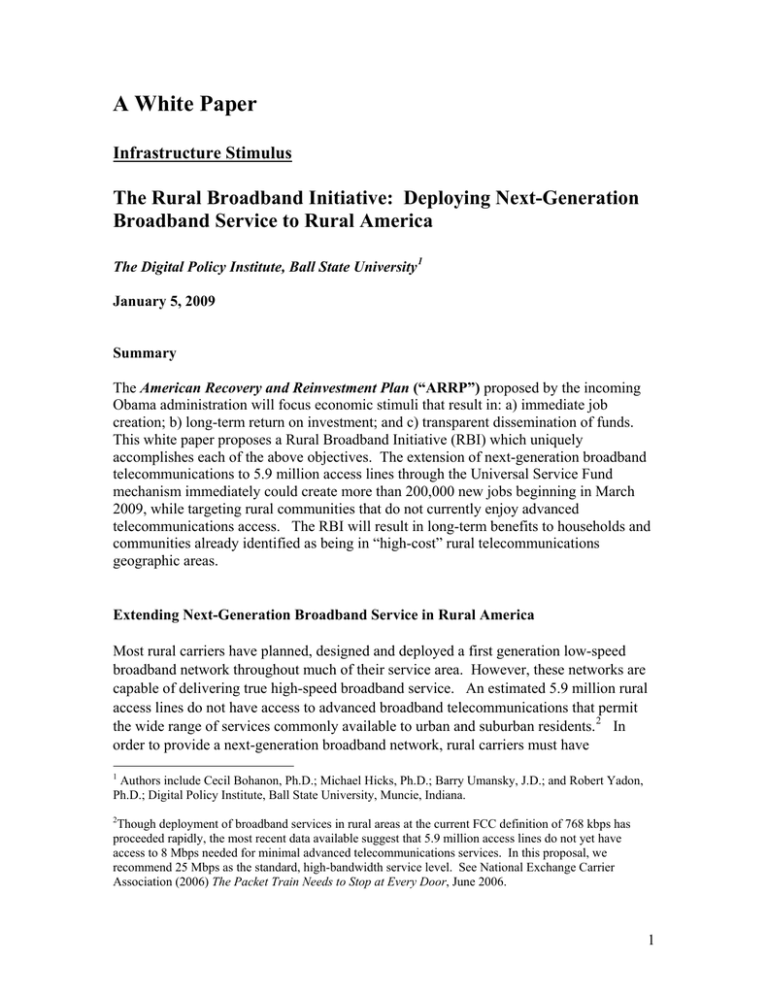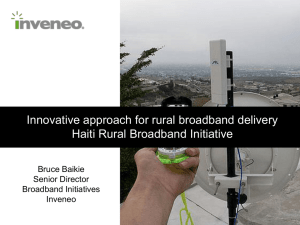A White Paper The Rural Broadband Initiative: Deploying Next-Generation
advertisement

A White Paper Infrastructure Stimulus The Rural Broadband Initiative: Deploying Next-Generation Broadband Service to Rural America The Digital Policy Institute, Ball State University 1 January 5, 2009 Summary The American Recovery and Reinvestment Plan (“ARRP”) proposed by the incoming Obama administration will focus economic stimuli that result in: a) immediate job creation; b) long-term return on investment; and c) transparent dissemination of funds. This white paper proposes a Rural Broadband Initiative (RBI) which uniquely accomplishes each of the above objectives. The extension of next-generation broadband telecommunications to 5.9 million access lines through the Universal Service Fund mechanism immediately could create more than 200,000 new jobs beginning in March 2009, while targeting rural communities that do not currently enjoy advanced telecommunications access. The RBI will result in long-term benefits to households and communities already identified as being in “high-cost” rural telecommunications geographic areas. Extending Next-Generation Broadband Service in Rural America Most rural carriers have planned, designed and deployed a first generation low-speed broadband network throughout much of their service area. However, these networks are capable of delivering true high-speed broadband service. An estimated 5.9 million rural access lines do not have access to advanced broadband telecommunications that permit the wide range of services commonly available to urban and suburban residents. 2 In order to provide a next-generation broadband network, rural carriers must have 1 Authors include Cecil Bohanon, Ph.D.; Michael Hicks, Ph.D.; Barry Umansky, J.D.; and Robert Yadon, Ph.D.; Digital Policy Institute, Ball State University, Muncie, Indiana. 2 Though deployment of broadband services in rural areas at the current FCC definition of 768 kbps has proceeded rapidly, the most recent data available suggest that 5.9 million access lines do not yet have access to 8 Mbps needed for minimal advanced telecommunications services. In this proposal, we recommend 25 Mbps as the standard, high-bandwidth service level. See National Exchange Carrier Association (2006) The Packet Train Needs to Stop at Every Door, June 2006. 1 reasonable broadband access to the Internet and deploy fiber optics much deeper within their rural networks and much closer to end user premises. However, due to low population density in rural areas viable deployment is not economically feasible. To remedy this telecommunications gap and create immediate employment opportunities through a transparent funding program, we recommend: ● An immediate allocation of funds from the American Recovery and Reinvestment Plan as a build-out grant to any current rural telecommunications provider to extend broadband infrastructure to 25 Mbps service. To be eligible a funding recipient must be willing to install the fiber-optic lines and network electronics, and be a Universal Service Fund (USF) recipient for high-cost service areas and be a rural telephone company as defined by the Telecommunications Act of 1996. 3 ● This grant is to be directed to current USF high-cost rural recipients as a onetime infrastructure project as part of the American Recovery and Reinvestment Plan. This process allows for expedited transmission of funds to permit almost immediate job creation and increased economic activity – stimulating the economy. ● The existing USF provides a transmission mechanism for Federal funds not currently associated with other broadband deployment options and already has established need-based criteria for recipients (“high-cost” service areas). Other proposals to extend broadband connectivity to schools, healthcare providers and consumers (through vouchers or similar mechanisms) could not generate job creation and increased economic activity in the coming months or years. ● Expenditures may only be used for interconnection to and deployment of fiberoptic networks in rural communities or areas, or on equipment, training or rightof-way acquisition for rural telecommunications, and ISP backbone transport access. ● This build-out will ensure provision of advanced broadband service. This plan will result in more than 200,000 new jobs beginning in early March 2009 – only 45 days after enactment of the legislation. 4 Upon passage of the legislation rural telecommunications providers will immediately begin ordering fiber-optic cable and telecommunications equipment, subsequently creating employment opportunities in manufacturing and transportation. Local engineering and 3 47 U.S.C. § 153(37). 4 These employment figures are conservative estimates, based on various studies identifying the relationship between expenditures on broadband deployment and employment in telecommunications, and the indirect and induced employment caused by expenditures in these areas. See Burton and Hicks, The Residential and Commercial Benefits of Rural Broadband, Marshall University (2005). We also assume passage of the ARRP legislation by the end of January, 2009. 2 construction firms are likely to begin the deployment of telecommunications equipment in late March 2009, weather permitting. Long term effects include productivity gains to rural regions and enhanced quality of life effects for rural households. ● This proposal will provide a minimum 25 Mbps service to approximately 5.9 million rural access lines currently without advanced broadband service. We believe this can be achieved at a cost of less than $28 billion, or 3.5% of the proposed stimulus expenditure proposed in the American Recovery and Reinvestment Plan. 5 Note: This will result in approximately 7% of the job creation targeted under the ARRP proposal. The purpose of the next-generation broadband build-out to rural communities and areas goes beyond the benefits of an immediate stimulus package. Consumers who currently do not have access to advanced broadband services would, under this proposal, be able to access those services. It should be noted, however, that access to broadband is not equivalent to actual adoption or use of advanced broadband service. Advanced broadband services currently are unavailable in these rural areas because the costs of the build-out, operation and maintenance of an advanced broadband network would require rates which are unaffordable to consumers and in excess of expected revenues to potential telecommunications providers. 6 By covering the costs of fiber build-out through unencumbered grants, rural telecommunications providers will have the incentive and ability to turn their efforts toward developing those currently underserved markets, and they will spend significant effort in educating and motivating their new broadband-ready customers to the benefits of next-generation broadband services. 7 Such education undoubtedly will be part of a wider public-private partnership that will include health care facilities, schools, universities, economic development agencies, libraries and local governments. This partnership will be instrumental in ensuring that the urban/rural digital divide becomes a thing of the past, and that rural community take rates for Internet services are comparable to urban take 5 This is derived from the estimate of $4,800 per line for 5.9 million access lines, per industry consultants. Also see National Exchange Carrier Association (2006) The Packet Train Needs to Stop at Every Door, June 2006, for additional cost estimates. 6 Rural local exchange carriers (RLECs) generally serve high-cost markets characterized by low access line density (i.e., an average of 13 access lines per square mile versus an average of 100 access lines in nonrural markets) and long average loop length (average loop length of over 20,000 feet versus 10,000 feet in non-rural markets). Standard & Poor’s (2003). 7 This type of subsidization has been empirically evaluated as leading to higher incremental adoption rates and greater levels of social gains than other subsidies. For example, “The subsidy to investment avoids the problem of low valuation consumers by inducing entry into un-served markets where the new adopters have very high valuations” Austan Goolsbee (2001) Subsidies, the Value of Broadband, and the Importance of Fixed Costs, in Broadband: Should we regulate high speed Internet access, eds., Crandall, Robert W. and Aleman, James H. AEI Brookings Joint Center for Regulatory Studies. 3 rates, and that the goal of universal advanced broadband service in the United States becomes a reality. It is important to note that the build-out grants envisioned will be one-time events. They will affect only marginally the ongoing discussion of long-term public policy toward telecommunications service provisions in high-cost areas. As geographical factors (e.g. mountain ranges) and demographic factors (e.g. low population density) that are the source of high costs are either immutable or slowly changing, there must be further development of policies that sustain both comparable take rates and comparable charges in high costs areas. Conclusion: It is clear that the focus of the ARRP has three foci: a) short-term job creation; b) longterm return on investment; and c) transparency of process. Funding the Rural Broadband Initiative uniquely meets each of these three foci. As soon as funding is committed to a specific rural telco orders will be placed for fiber optic cable and electronics equipment to be used in the deployment. This will provide immediate need for manufacturing capacities and related employment. Engineering, consulting and cable plant construction positions will be in immediate demand. The almost immediate creation of jobs and the ability to utilize the existing Universal Service Fund mechanism to identify and distribute funding with almost no delay makes the RBI uniquely qualified for inclusion in the ARRP. We believe a special investment grant to high-cost USF recipients in rural communities and areas will meet all the criteria specified for funding consideration within the ARRP. 8 For More Information Contact: Robert E. Yadon, Ph.D. Senior Research Fellow Digital Policy Institute Ball State University Muncie, IN 47306 (765) 285-1515 ryadon@bsu.edu 8 See Lawrence Summers, Obama’s Down Payment, December 28, 2008. “Some argue that instead of attempting to both create jobs and invest in our long-run growth, we should focus exclusively on short-term policies that generate consumer spending. . . but that approach led to some of the challenges we face today -- and it is that approach that we must reject if we are going to strengthen our middle class and our economy over the long run." 4 ABOUT THE DIGITAL POLICY INSTITUTE: The Digital Policy Institute (DPI) is an independent think tank within the Ball State University (BSU) academic community that serves as an interdisciplinary association of faculty with a collective research interest in the structure of, and competition within, electronic communications industries and the public policy of digital creation, storage, transmission, reception, consumption and legal protection of information of various forms, including written, voice, data, still images, video and computer graphics, in the 21st century. For more information see: www.bsu.edu/digitalpolicy. 5

